#ercole d'este
Photo
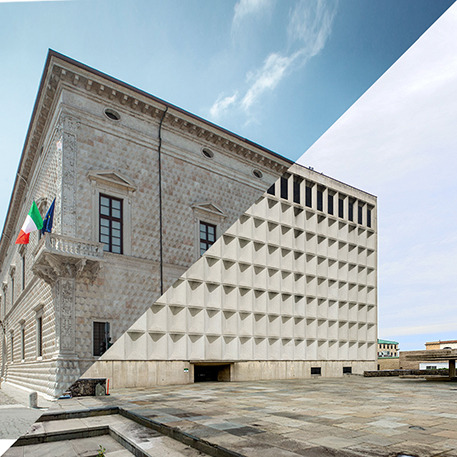
Biagio Rossetti, Palazzo dei Diamanti, Ferrara, Italy, 1493-1503
VS
Marcel Breuer, Tech II, New York University, New York, USA, 1956-1961
#biagio rossetti#addizione erculea#ferrara#italy#italia#renaissance#rinascimento#estensi#Ercole I d'Este#Sigismondo I d'Este#Quadrivio degli Angeli#marcel breuer#new york#nyc#ny#usa#new york university#tech ii#diamond
42 notes
·
View notes
Photo
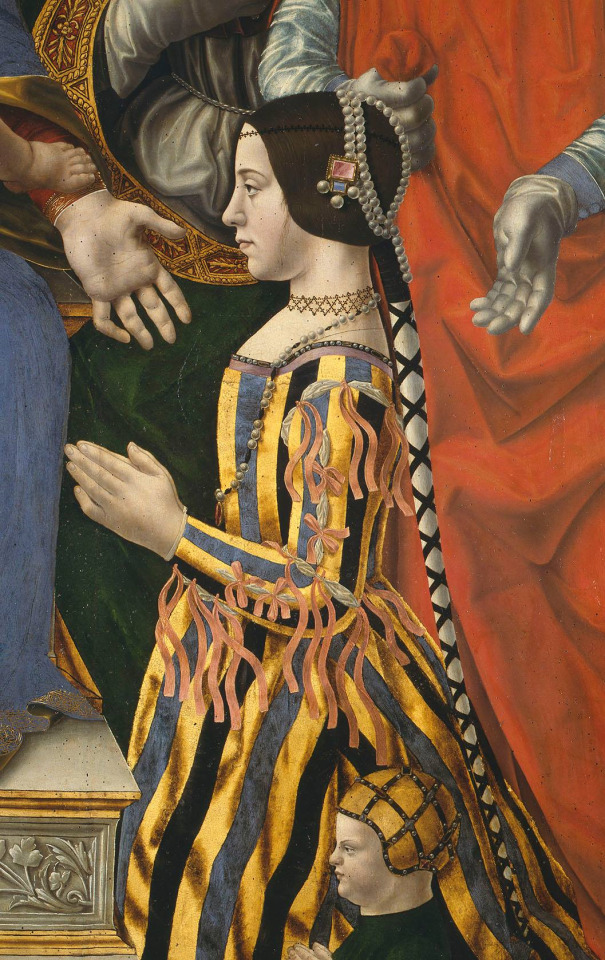
Portrait of Beatrice d'Este and her son Ercole Massimiliano, detail from the Pala Sforzesca
#Beatrice d'Este#art#italian#italy#italian peninsula#fine art#european art#european history#western civilization#duchess#milan#world history#brunette#female portrait#medieval#Medieval Times#church#catholic#catholicism#christian#christianity#Christendom
59 notes
·
View notes
Photo

Renée of France (25 October 1510 – 12 June 1574), was Duchess of Ferrara from 31 October 1534 until 3 October 1559 by marriage to Ercole II d'Este, grandson of Pope Alexander VI. She was the younger surviving child of Louis XII of France and the duchess regnant Anne of Brittany. In her later life, she became an important supporter of the Protestant Reformation and ally of John Calvin.
5 notes
·
View notes
Text
Prince of Foxes (1949).

"El príncipe de los zorros" o en su idioma original “Prince of foxes” no sitúa en la Italia del renacimiento a mediados de agosto de 1500, y no abre en un escenario de un velorio, el velorio de Alfonso de Aragón Príncipe de Salerno y esposo de Lucrezia Borgia es aquí donde nos muestran a los personajes principales de la trama, entre ellos al protagonista de la obra Andrea Orsini, un noble y aficionado al arte, el cual igual de habilidoso que es con el pincel lo es con las palabras y lleno de ambiciones, sirve como soldado al maquiavélico príncipe César Borgia el cual en la historia real es hijo del polémico Papa Alejandro VI y por ello ostenta tal poder. Durante esta primera escena vemos el buen trabajo hecho con la escenografía, la arquitectura representada siguiendo los cánones clásicos y tipologías propias de las iglesias del renacimiento sumándole la vestimenta de los actores ayudan a crea una experiencia inmersiva, intente encontrar información sobre el nombre de la misma iglesia, pero difícilmente pude encontrar nada más allá de la mención de que se la cinta se rodó en Italia y los las estructuras vistas en la misma son auténticas.
Dicho lo anterior proseguimos con la narrativa donde en poco tiempo nos muestran el objetivo principal Cesar Borgia donde selecciona a Andrea para llevar a cabo una intriga, esta misión consiste en arreglar el matrimonio de su hermana viuda, Lucrezia y a Alfonso d’Este, hijo del duque Ercole d'Este de Ferrara, dando a entender que la muerte de su cuñado fue ordenada por este mismo para sacarle provecho diplomático. Bajo esta escena nos muestran parte de la actitud del que posteriormente se nos presenta como protagonista de la obra, pero cuyas acciones y forma de pensar ya nos intuía este desenlace, gracias a ello Borgia eliminará a Ferrara como un impedimento para la conquista del centro de Italia y la posterior unificación de la península italiana.
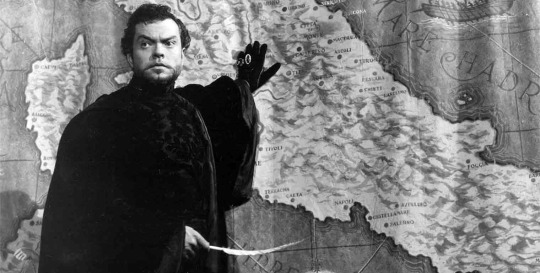
Andrea viaja a Venecia para vender algunos de sus cuadros y así recaudar dinero para los gastos de su misión, cabe resaltar que las imágenes que vemos son la real Venecia, tanto que se aprecia como existen la Campanile de San Marcos, Palacio Ducal de Venecia y el Palazzo della Librería (este último construido de entre 30 a 50 años después de la época donde nos situamos). Allí es donde conoce a otro personaje importante de la trama la cual señorita Camilla di Baglione, joven esposa del anciano conde Marc Antonio Varano de Citta del Monte. Durante su travesía a ferrara se nos muestra parte de la actitud de Andrea, un hombre confiado, carismático y bueno con el uso de las palabras tanto que convence a un asesino de contratarlo a pesar de que el mismo intento asesinarlo, además de mostrar dotes con el manejo de la espada. En ese mismo trayecto se detiene para visitar la granja de la viuda de un herrero. Ella es en realidad su madre, es aquí donde se nos muestra que el protagonista no es en realidad un noble si no un campesino y su nombre real es Andrea Zoppo y no el noble Orsini que pretende ser.
Al finalizar esta misión con éxito, se le encarga otra, esta vez una de asesinato donde su objetivo es la de embajador en la ciudad montañera de Citta del Monte (esta última existiendo solo en el universo de la cinta y cuya ubicación seria la actual San Marino), con órdenes de ayudar a Borgia a conquistar la ciudad en la cima de la montaña antes de la primavera, utilizando una conquista romántica de Camilla para facilitar el asesinato del anciano conde. Durante su estancia ocurren una serie de eventos que cambian la visión del protagonista mientras el amor hacia Camilla no hace más que aumentar y al mismo tiempo se ve cautivado por la sabiduría del hombre mayor y el amor por su pueblo.

El tiempo se agota y es donde llega Don Esteban, capitán de los ejércitos de Borgia para imponer sus condiciones a la ciudad. Es aquí donde Andrea Orsini despeja las dudas que durante meses se han ido acumulando en su cabeza y decide ayudar al Conde ante el ataque de las tropas de Borgia.
Durante un cruento asedio, el cual se sitúa en la actual Monte Titano en San Marino, el conde es herido de muerte en una emboscada, a partir de ahora el protagonista toma la defensa de la ciudad.

Después de tres meses de repeler los ataques, la ciudad se encuentra en sus últimas, aquí Orsini decide entregarse para que aceptar las condiciones de rendición y que la ciudad sobreviva, este es sentenciado a quedar ciego Belli, el asesino que se había vuelto su amigo es quien lo deja ciego con sus propias manos, pero es todo un truco para lograr salvar Andrea y finge la desfiguración, posteriormente juntos planean el rescate de Camila y junto a un levantamiento en la ciudad de Citta del monte logran liberarla, causando una resistencia en contra de la casa Borgia que culminaría con su caída. Finalizando esta obra con el casamiento del campesino Andrea Zoppo y Camilla di Baglione.

A lo largo de esta obra nos deja muy en claro lo complicado de los tiempos del renacimiento, una época llena de intriga, conspiraciones y guerras, el príncipe de los zorros nos trata de narrar desde un punto de vista algo fantasioso estos hechos, ya que, aunque en base se representa en sucesos reales, a partir de cierto punto de la trama sigue con la narrativa de la novela en la que se inspira originalmente la obra, siento que narra demuestra bien lo que podría ser a nuestros ojos el día a día de ese entonces, la presencia de obras de arte y frescos además de la utilería y las ropas te hace sentir que estas en la época a pesar de ciertas incongruencias históricas y las limitaciones de la misma época en la que se produjo. A pesar de la calidad de la cinta y el blanco y negro aun se logra preciar el paisaje de los montes italianos e incluso acompaña la narrativa de impresionantes coreografías de batallas donde combinan ese paso histórico entre lo medieval y la proliferación de la pólvora. La arquitectura también se lleva una porción del pastel a pesar de mostrar planos interiores la mayoría de las veces, la cinta nos muestra lugres emblemáticos Roma, San Gimignano, San Marino, Venecia y del Véneto.
0 notes
Text
Ludovico Ariosto, poeta del Rinascimento
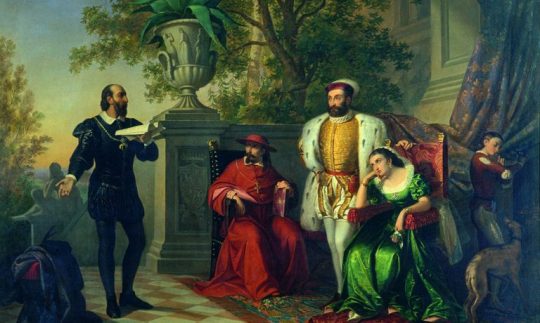
Uno dei personaggi fondamentali della storia della poesia italiana…
Ludovico Ariosto nacque a Reggio Emilia l’8 settembre 1474, il padre Niccolò era capitano della rocca della città e a causa dei suoi incarichi lavorativi impose alla famiglia una serie di spostamenti, prima a Rovigo nel 1481, poi a Venezia e Reggio ed infine a Ferrara nel 1484.
Per volere del padre, Ludovico cominciò a studiare legge tra il 1484 e il 1494, oltre a frequentare la corte estense di Ercole I, dove venne a contatto con illustri personaggi dell'epoca tra cui Ercole Strozzi e Pietro Bembo.
Gli anni più felici dell’ Ariosto furono quelli tra il 1495 e il 1500 quando poté occuparsi dello studio della letteratura, che è la sua vera passione.
Il primo evento che sconvolse la vita di Ludovico fu la morte del padre nel 1500 dato che, come primogenito, doveva occuparsi delle sue cinque sorelle e dei quattro fratelli rimasti orfani.
Nel 1502 accettò il capitanato della rocca di Canossa e li ebbe un figlio, Giambattista, nato dalla relazione con la cameriera Maria, seguito dopo poco tempo dalla nascita di un secondo figlio, Virginio, avuto dalla relazione con Olimpia Sassomarino.
Ariosto nel 1503 prese gli ordini ecclesiastici minori ed entrò alle dipendenze del cardinale Ippolito d'Este, barcamenandosi tra incarichi amministrativi, servizi da cameriere personale, missioni politiche e diplomatiche.
Tra il 1507 e il 1515 fu ad Urbino, Venezia, Firenze, Bologna, Modena Mantova e Roma, oltre ad essere impegnato nella stesura di L’Orlando Furioso e la scrittura e la messa in scena di alcuni lavori teatrali come le commedie Cassaria e I Suppositi.
Nel 1510 il cardinale Ippolito ricevette una scomunica dal papa Giulio II e Ariosto andò a perorare la sua causa a Roma, ma non ebbe una buona accoglienza dal papa.
Il poeta nel 1512 fuggì attraverso gli Appennini con il duca Alfonso, per sottrarsi alle ire papali, scatenate dall'alleanza tra gli Estensi e i francesi nella guerra della Lega Santa, poi andò a Firenze dove conobbe Alessandra Balducci, la moglie di Tito Strozzi, di cui si innamorò perdutamente.
Dopo la morte del marito, avvenuta nel 1515, Alessandra si trasferì a Ferrara e tra i due ha inizio una lunga relazione che culminò in un matrimonio segreto nel 1527.
Il rapporto tra Ariosto e il cardinale peggiorò a seguito della pubblicazione dell’Orlando Furioso nel 1516, poi Ludovico si rifiutò di seguire il Cardinale in Ungheria, dove fu nominato vescovo di Buda, e venne licenziato.
Nel 1517 il poeta passò alle dipendenze del duca Alfonso d'Este e, dopo la riacquisizione da parte degli Estensi della Garfagnana, fu prescelto come governatore di quei territori dal 1522 al 1525 facendo il possibile per liberarli dai briganti che li infestano, dopodiché tornò a Ferrara.
Ludovico visse i suoi ultimi anni di vita in completa tranquillità nella sua casetta di Mirasole, circondato dall'amore del figlio Virginio e della moglie Alessandra, oltre a dedicarsi alla revisione dell'Orlando Furioso, prima di morire il 6 luglio 1533, all'età di 58 anni.
Read the full article
0 notes
Text
INGLESIA Y CONJUNTO PARROQUIAL ‘SAN GIACOMO APOSTOLO’

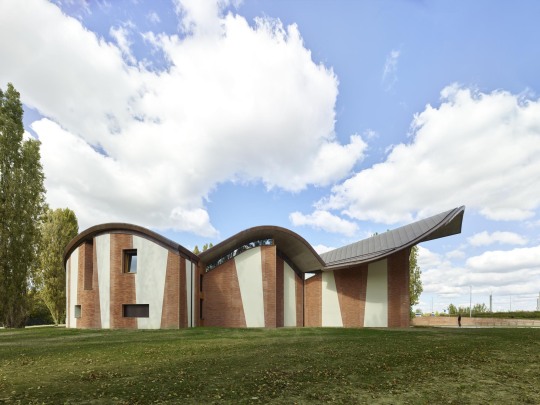
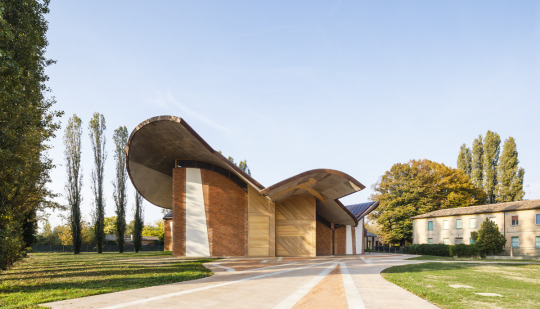
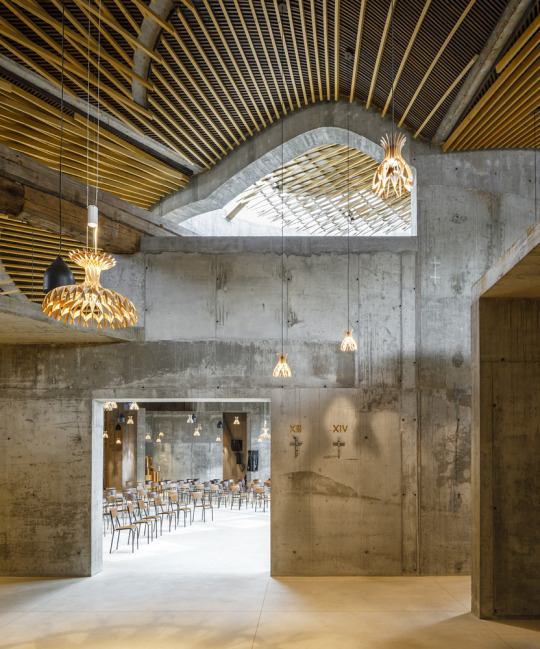



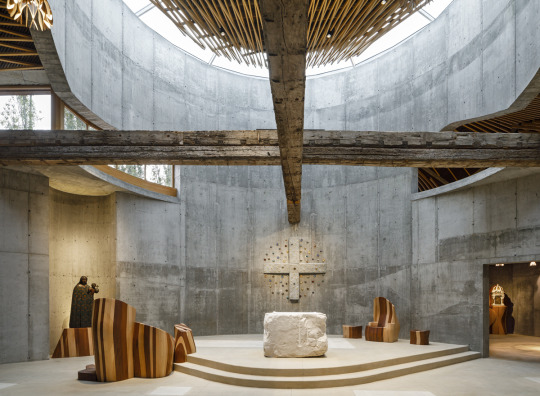




La obra en la que trabajaremos es la iglesia de san Giacomo apóstol, diseñada por EMBT Architects, en el año 2021. Esta obra se encuentra en Ferrara, una pequeña ciudad del norte de Italia.
BENEDETTA TAGLIABUE
Benedetta Tagliabue - EMBT Arquitectos es un estudio de arquitectura reconocido internacionalmente, fundado en 1994 por la asociación de Enric Miralles (1955-2000) y Benedetta Tagliabue en Barcelona. Casualmente, esta colaboración comenzó justo antes del inicio de los Juegos Olímpicos de 1992 en Barcelona, un periodo de apogeo para la ciudad y su arquitectura.
Tras el prematuro fallecimiento de Enric Miralles en el año 2000, marido y socio de Benedetta, ésta continuó dirigiendo su despacho como socia única, terminando más de diez obras inacabadas de Enric y comenzando otras nuevas.
Benedetta Tagliabue - El enfoque maduro de EMBT hacia la arquitectura, el diseño de interiores y la planificación de instalaciones incluye experiencia en edificios educativos, comerciales, industriales y residenciales, restauración de edificios y arquitectura paisajística con fines especiales.
Los proyectos actuales de la empresa incluyen la Escuela de Administración de la Universidad de Fudan en Shanghai, torres de oficinas en Xiamen y Taichung, espacios públicos en HafenCity en Hamburgo (Alemania), la estación de metro de Clichy-Montfermeil en París (Francia) (primer premio en el concurso) y la estación central de metro de Nápoles (Italia), entre otros.
Benedetta Tagliabue - La arquitectura poética de EMBT, siempre atenta al contexto, puede verse como un crisol de ideas, un punto de encuentro de tradiciones e innovaciones, donde cada proyecto supone un reto y al mismo tiempo una nueva oportunidad de aprendizaje. Nuestra filosofía refleja la creencia en cambiar el entorno observando y respetando el lugar, su historia y su cultura.
INGLESIA Y CONJUNTO PARROQUIAL ‘SAN GIACOMO APOSTOLO’
Fruto de un concurso ganado en 2011, la Iglesia y Parroquia de San Giacomo diseñada por el estudio español EMBT, dirigido por Benedetta Tagliabue, se ha completado en las afueras de Ferrara, una ciudad ideal construida en la época del Renacimiento, por el arquitecto y urbanista Biagio Rossetti, para Ercole d'Este, duque de Ferrara.
El trabajo se desarrolló durante una década (2011-2021). El complejo consta de una iglesia de 710 metros cuadrados, un complejo parroquial de 873 metros cuadrados y un jardín de 600 metros cuadrados. Benedetta Tagliabue - EMBT colaboró con el artista italiano Enzo Cucchi, que diseñó la iconografía de esta iglesia dedicada al apóstol Santiago.
El nuevo lugar de culto diseñado por Benedetta Tagliabue - EMBT, la Iglesia y Parroquia de San Giacomo, contrasta su forma orgánica y abierta con la densa morfología de los edificios vecinos.
El proyecto, en un terreno vacío rodeado de álamos, inspirado en el festival anual de globos aerostáticos de Ferrara, despliega de forma radial una serie de bóvedas parabólicas y las hace confluir en un lucernario situado en lo alto del altar, sobre el que también se asoma una enorme cruz horizontal hecha con trozos de madera sobrantes de la renovación del histórico Ayuntamiento.
Todo ello cubierto por un fino tejado de hormigón ondulado (utilizar madera era demasiado caro) con un concepto inspirado en la remodelación del mercado de Santa Caterina de Barcelona en 2004.
Encargada por la archidiócesis de Ferrara-Comacchio, la iglesia se construyó para atender a una congregación de 300 feligreses, junto con una casa para el párroco y un salón parroquial.
El complejo cuenta con una iglesia semicircular (cuyo altar mayor, orientado al este, se eleva en el epicentro del conjunto), detrás de ella la casa del párroco y, al sur, "como la cola de un cometa", el salón parroquial y los espacios anexos.
El espacio principal está inundado por la luz del día desde arriba y anima a los visitantes a levantar la cabeza hacia el cielo, especialmente en el altar mayor, de forma típica en la arquitectura de las iglesias, donde los feligreses verán una gigantesca cruz de madera que atraviesa el vacío.
El exterior de la iglesia está revestido con tiras de ladrillo y yeso típicas de Ferrara (con los ladrillos también con una fachada de dientes de sierra especialmente diseñada para evocar el Palacio de los Diamantes del siglo XV de la ciudad, conocido por su sillar facetado).
El interior está iluminado por lámparas colgantes hechas de finos listones de madera que componen pequeñas cúpulas que irradian luz, creando geometrías poéticas y reflejos angelicales. Están diseñados por Benedetta Tagliabue y producidos por el fabricante barcelonés Bover.
Caracterizada por su excepcional volumen y sus rasgos formales, la iglesia se percibe inmediatamente como un edificio monumental de propiedad pública.
La forma ondulada del techo escultórico remite a la forma arquetípica de las naves románicas y góticas. Sin embargo, su paralelismo se recompone de forma radial, y en el centro se encuentra el altar del que parten las bóvedas parabólicas.
Asimismo, el gran portal de entrada, junto con el umbral del patio de la iglesia, marca de forma muy simbólica la entrada al templo, cuyas fachadas de ladrillo y yeso enfatizan el carácter de conjunto del espacio interior.
En el interior de la iglesia, la cubierta abovedada de madera, que recuerda a las naves de las iglesias medievales, irradia alrededor de un anillo de luz que rodea un dosel suspendido. Una gran cruz de vigas de madera vuela sobre toda la nave. Las vigas, rescatadas del antiguo ayuntamiento de Ferrara y sustituidas durante la restauración, muestran una sólida y antigua relación con la ciudad.
BIBLIOGRAFIA
https://www.archdaily.com/975287/san-giacomo-apostolo-church-and-parish-complex-miralles-tagliabue-embt, 18 octubre 2022
http://www.mirallestagliabue.com/project/san-giacomo-church/,18 octubre 2022
https://arquitecturaviva.com/works/iglesia-y-centro-parroquial-de-san-giacomo-ferrara-3143, 18 octubre 2022
https://www.archilovers.com/projects/296921/san-giacomo-apostolo.html,18 octubre 2022
0 notes
Text

Artista: Pompeo Leoni (Milanés, c. 1533 – 1608)
Título: Ercole II d'Este, 1508-1559, cuarto duque de Ferrara 1534 [anverso]
Con fecha de 1554
Clasificación: Escultura
Medio: plomo
Dimensiones totales (diámetro): 6,94 cm, peso bruto: 127,23 gr, eje: 6:00
Crédito: Colección Samuel H. Kress, National Gallery of Art
Información e imagen de la web del museo
0 notes
Text
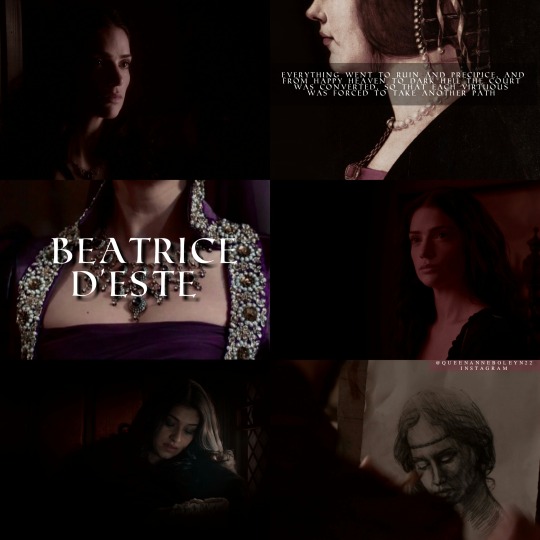
Beatrice d'Este (29 June 1475 – 3 January 1497), duchess of Bari and later of Milan, was the wife of the Milanese ruler Ludovico Sforza (known as "il Moro"). She was one of the most beautiful and accomplished princesses of the Italian Renaissance. A member of the Este family, she was the younger daughter of Ercole I d'Este and the sister of Isabella d'Este and Alfonso d'Este. Along with her sister, Beatrice was noted for her excellent taste in fashion and for having invented new clothing styles.
The Ferrarese house of Este and the Milanese house of Sforza had always been on friendly terms and in 1480, in order to cement an alliance, Ludovico Sforza formally asked Ercole d'Este to give him the hand of his daughter in marriage. Ludovico, who was then duke of Bari and regent to the duke of Milan, had originally requested a betrothal to Isabella, Beatrice's older sister, but because she was already promised to Francesco Gonzaga, Ercole offered him Beatrice instead. Il Moro made no objection to the arrangement and Beatrice was married to him in January 1491.The official nuptials were to have taken place in 1490 in a double wedding with Beatrice marrying Ludovico and Isabella marrying Francesco at the same time, but the Duke of Bari postponed it more than once. Finally, around a year later, they were wed in a double Sforza-Este wedding: Ludovico married Beatrice, while Beatrice's brother, Alfonso d'Este, married Anna Sforza, the sister of Gian Galeazzo Sforza. Leonardo da Vinci orchestrated the wedding celebration.
"A daughter was born this day to Duke Ercole, and received the name of Beatrice, being the child of Madonna Leonora his wife. And there were no rejoicings, because every one wished for a boy."
Beatrice had been carefully educated, and availed herself of her position as mistress of one of the most splendid courts of Italy to gather around her learned men, poets and artists, such as Niccolò da Correggio, Bernardo Castiglione, Donato Bramante, Leonardo da Vinci, and many others.In 1492 she visited Venice as ambassador for her husband in his political schemes, which consisted chiefly of a desire to be recognized as duke of Milan. On the death of Gian Galeazzo Sforza, Ludovico's usurpation was legalized, and after the Battle of Fornovo (1495), both he and his wife took part in the peace congress of Vercelli between Charles VIII of France and the Italian princes, at which Beatrice showed great political ability.
However, her brilliant career was cut short by death through childbirth, on 3 January 1497 at the age of 21. In a letter written hours after her death, Ludovico informed his brother-in-law Francesco Gonzaga that his wife, "gave back her spirit to God" half an hour after midnight. Their child had been born at eleven at night and was a stillborn son.
"And when Duchess Beatrice died," wrote the poet, Vincenzo Calmeta, "everything fell into ruin, and that court, which had been a joyous paradise, was changed into a black Inferno."
Beatrice d'Este belonged to the best class of Renaissance women, and was one of the cultural influences of the age; to a great extent, her patronage and good taste are responsible for the splendour of the Castello Sforzesco in Milan, the Certosa of Pavia, and many other famous buildings in Lombardy. Her tomb is preserved in the Certosa di Pavia where she is buried beside her husband Ludovico Sforza.
Her children by Ludovico Sforza:
-Massimiliano Sforza (25 January 1493 – 4 June 1530), duke of Milan 1512–1515.
-Francesco II Sforza (4 February 1495 – 24 October 1535), duke of Milan 1521–1535.
-Stillborn son (3 January 1497).
Source: "BEATRICE D'ESTE DUCHESS OF MILAN 1475-1497 A STUDY OF THE RENAISSANCE" BY JULIA CARTWRIGHT
"This duke had for his most dear wife Beatrice d'Este, daughter of Ercole, Duke of Ferrara, who, coming to Milan in the flower of her opening youth, was endowed with so rare an intellect, so much grace and affability, and was so remarkable for her generosity and goodness that she may justly be compared with the noblest women of antiquity. This duchess devoted her time to the highest objects. Her court was composed of men of talent and distinction, most of whom were poets and musicians, who were expected to compose new eclogues, comedies, or tragedies, and arrange new spectacles and representations every month. In her leisure hours she generally employed a certain Antonio Grifo"—a well-known student and commentator of Dante—"or some equally gifted man, to read the Divina Commedia, or the works of other Italian poets, aloud to her. And it was no small relaxation of mind for Lodovico Sforza, when he was able to escape from the cares and business of state, to come and listen to these readings in his wife's rooms. And among the illustrious men whose presence adorned the court of the duchess there were three high-born cavaliers, renowned for many talents, but above all for their poetic gifts—Niccolo da Correggio, Gaspare Visconti, and Antonio di Campo Fregoso, together with many others, one of whom was myself, Vincenzo Calmeta, who for some years held the post of secretary to that glorious and excellent lady. And besides those I have named there was Benedetto da Cingoli, called Piceno, and many other youths of no small promise, who daily offered her the first fruits of their genius. Nor was Duchess Beatrice content with rewarding and honouring the poets of her own court. On the contrary, she sent to all parts of Italy to inquire for the compositions of elegant poets, and placed their books as sacred and divine things on the shelves of her cabinet of study, and praised and rewarded each writer according to his merit. In this manner, poetry and literature in the vulgar tongue, which had degenerated and sunk into forgetfulness after the days of Petrarch and Boccaccio, has been restored to its former dignity, first by the protection of Lorenzo de' Medici, and then by the influence of this rare lady, and others like her, who are still living at the present time. But when Duchess Beatrice died everything fell into ruin. That court, which had been a joyous Paradise, became a dark and gloomy Inferno, and poets and artists were forced to seek another road."
"If in Isabella we have the supreme representative of Renaissance culture in its highest and most intellectual phase, Beatrice is the type of that new-found joy in life, that intoxicating rapture in the actual sense of existence, that was the heritage of her generation, and found expression in the words of a contemporary novelist, Matteo Bandello—himself of Lombard birth—when with his last breath he bade his companions live joyously, "Vivete lieti!" We see this bride of sixteen summers flinging herself with passionate delight into every amusement, singing gay songs with her courtiers, dancing and hunting through the livelong day, outstripping all her companions in the chase, and laughing in the face of danger. We see her holding her court in the famous Castello of Porta Giovia or in the summer palaces of Vigevano and Cussago, in these golden days when Milan was called the new Athens, when Leonardo and Bramante decorated palaces or arranged masquerades at the duke's bidding, when Gaspare Visconti wrote sonnets in illuminated books, and Lorenzo da Pavia constructed organs or viols as perfect and beautiful to see as to hear, for the pleasure of the youthful duchess. Scholars and poets, painters and writers, gallant soldiers and accomplished cavaliers, we see them all at Beatrice's feet, striving how best they may gratify her fancies and win her smiles. Young and old, they were alike devoted to her service, from Galeazzo di Sanseverino, the valiant captain who became her willing slave and chosen companion, to Niccolo da Correggio, that all-accomplished gentleman who laid down his pen and sword to design elaborate devices for his mistress's new gowns. We read her merry letters to her husband and sister, letters sparkling with wit and gaiety and overflowing with simple and natural affection. We see her rejoicing with all a young mother's proud delight over her first-born son, repeating, as mothers will, marvellous tales of his size and growth, and framing tender phrases for his infant lips. And we catch glimpses of her, too, in sadder moods, mourning her mother's loss or wounded by neglect and unkindness. We note how keenly her proud spirit resents wrong and injustice, and how in her turn she is not always careful of the rights and feelings of her rivals. But whatever her faults and mistakes may have been, she is always kindly and generous, human and lovable. A year or two passes, and we see her, royally arrayed in brocade and jewels, standing up in the great council hall of Venice, to plead her husband's cause before the Doge and Senate. Later on we find her sharing her lord's counsels in court and camp, receiving king and emperor at Pavia or Vigevano, fascinating the susceptible heart of Charles VIII. by her charms, and amazing Kaiser Maximilian by her wisdom and judgment in affairs of state. And then suddenly the music and dancing, the feasting and travelling, cease, and the richly coloured and animated pageant is brought to an abrupt close. Beatrice dies, without a moment's warning, in the flower of youth and beauty, and the young duchess is borne to her grave in S. Maria delle Grazie amid the tears and lamentations of all Milan. And with her death, the whole Milanese state, that fabric which Lodovico Sforza had built up at such infinite cost and pains, crumbles into ruin. Fortune, which till that hour had smiled so kindly on the Moro and had raised him to giddy heights of prosperity, now turned her back upon him. In three short years he had lost everything—crown, home, and liberty—and was left to drag out a miserable existence in the dungeons of Berry and Touraine.
#anna sforza#ercole d'este#d'este#beatrice d'este#janet montgomery#italian history#italian renaissance#rinascimento#leonardo da vinci#ludovico il moro#ludovico sforza#perioddramaedit#history#edit#history edit#ferrara#donne della storia#donne nella storia#renaissance italy#donne italiane#women of renaissance#renaissance#isabella d'este#alfonso d'este#15th century#duchess of bari#francesco gonzaga#vincenzo calmeta#gian galeazzo sforza#renaissance women
62 notes
·
View notes
Photo

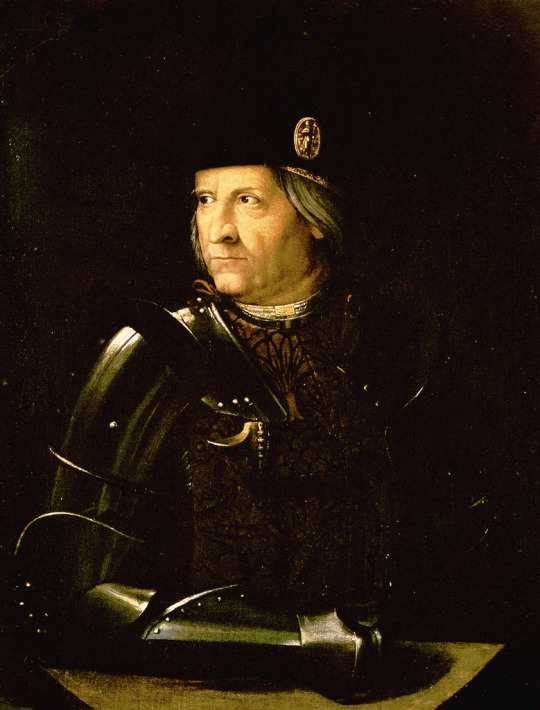

“ But a few days afterwards, while Duke Ercole was away from Ferrara, his wife was surprised by a sudden rising, the result of a deep-laid conspiracy, secretly planned by his nephew, Niccolo, a bastard son of Leonello d'Este. Niccolo's first endeavour was to seize on the person of the duchess and her young children, an attempt which almost proved successful, but was fortunately defeated by Leonora's own courage and presence of mind. The palace was already surrounded by armed men, when the alarm reached the ears of the duchess, and, springing out of bed with her infant son in her arms, followed by her two little daughters and a few faithful servants, she fled by the covered way to the Castello. Hardly had she left her room, when the conspirators rushed in and sacked the palace, killing all who tried to offer resistance. The people of Ferrara, however, were loyal to their beloved duke and duchess. After a few days of anxious suspense, Ercole returned, and soon quelled the tumult and restored order in the city. That evening he appeared on the balcony of the Castello, and publicly embraced his wife and children amid the shouts and applause of the whole city. The next day the whole ducal family went in solemn procession to the Cathedral, and there gave public thanks for their marvellous deliverance. A terrible list of cruel reprisals followed upon this rebellion, and Niccolo d'Este himself, with two hundred of his partisans, were put to death after the bloody fashion of the times. “- Julia Cartwright, Beatrice d'Este, Duchess of Milan, 1475-1497
#Leonora of Aragon#Eleanor of Naples#Eleonora d'Aragona#Ercole d'Este#Duchess of Ferrara#Duke of Ferrara#Italian history#Women in history#Men in history
8 notes
·
View notes
Quote
[...]when Lucrezia received a brief from her father supporting her claims for her allowance, and passed it on to one of Ercole's gentlemen for Ercole to read, he answered icily that he would not give way "even if God came to see us." Lucrezia's fury increased. It reached such a pitch that one day, when the Duke was paying her a customary call, she could not endure the irony of small talk any longer and burst out saying that it would have been better if the Duke had stayed at home to "settle his accounts."
The Life and Times of Lucrezia Borgia, Maria Bellonci
#lucrezia borgia#ercole d'este#auth: maria bellonci#lmaooo#my borgia princess#i'd have acted the same way#if not worse#i really love to see these moments where the borgias's patience and diplomacy runs out#and their spaniard blood speaks louder#and they just are painfully honest and ironic in their remarks#it's like their masks coming off for a bit you know
6 notes
·
View notes
Photo
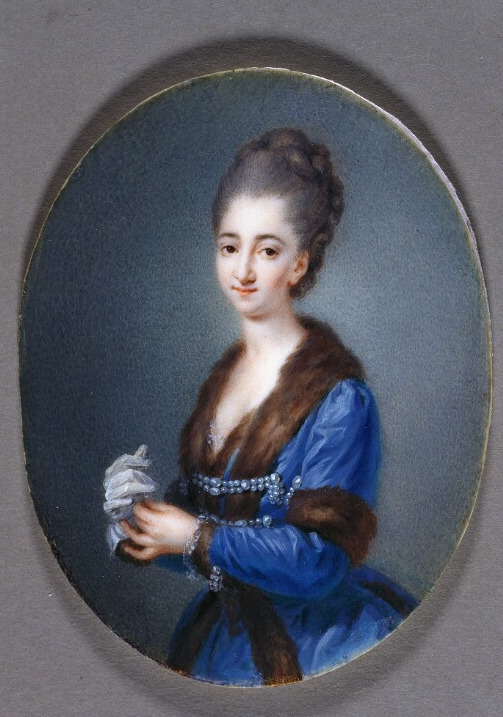
A miniature of Maria Beatrice d'Este, Duchess of Massa. She was born on this day, April 7th, in 1750. She was the only surviving child of Ercole III d'Este, Duke of Modena and Reggio, and Maria Teresa Cybo-Malaspina, reigning duchess of Massa and princess of Carrara. As their only surviving child, she was heiress to both her parents titles, and was highly sought after as a bride.
Ultimately she was married to Archduke Ferdinand, one of the sons of Maria Theresa and Francis I. Their marriage created a new branch of the house of Habsburg Lorraine, the House of Austria-Este. The couple had ten children together, with 7 surviving to adulthood.
Maria Beatrice inherited her mother’s titles as sovereign Duchess of Massa and Carrara when she died in 1790, but her father’s titles would pass to her eldest son Francis, since Modena and Reggio didn’t allow female succession. She died in 1829, and her titles then also passed to her son.
#maria beatrice d'este#Maria Teresa Cybo-Malaspina#Ercole III d'Este#archduke ferdinand#house of austria-este#long live the queue
55 notes
·
View notes
Photo
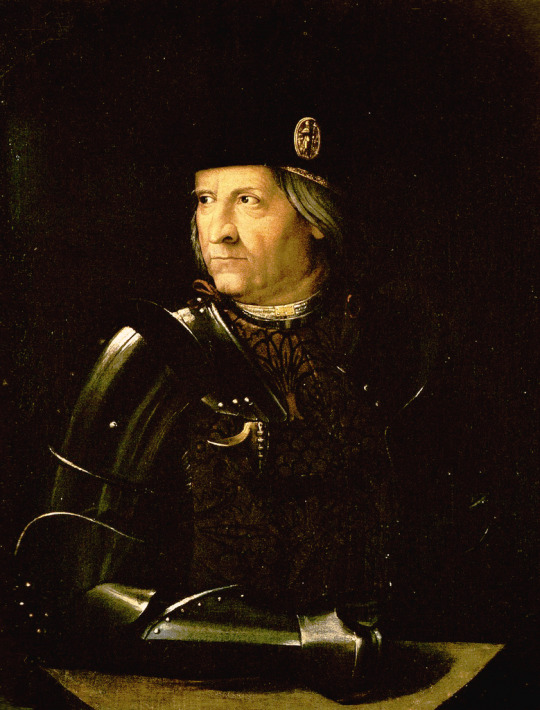
Ercole I d'Este - possibly by Dosso Dossi (1520-1530)
https://gallerie-estensi.beniculturali.it/en
#ercole i d'este#dosso dossi#painting#portrait#1500s#black#gallerie estensi#italy#high renaissance#renaissance#school of ferrara
0 notes
Video
youtube
The Hilliard Ensemble / Josquin Desprez / Absalon, fili mi (attrib.) (Missa Hercules Dux Ferrariae. Motets, 2004)
Absalon, fili mi (attrib.) · · Paul Hillier : Missa "Hercules dux Ferrariae", Motets and chansons
#the hilliard ensemble#josquin desprez#absalon fili mi#Missa Hercules Dux Ferrariae#motets#classical#audio#2004#2000s#paul hillier#warner#1400s#1500s#soggetto cavato#Ercole d'Este I#cantus firmus#polyphonic#mass
1 note
·
View note
Photo
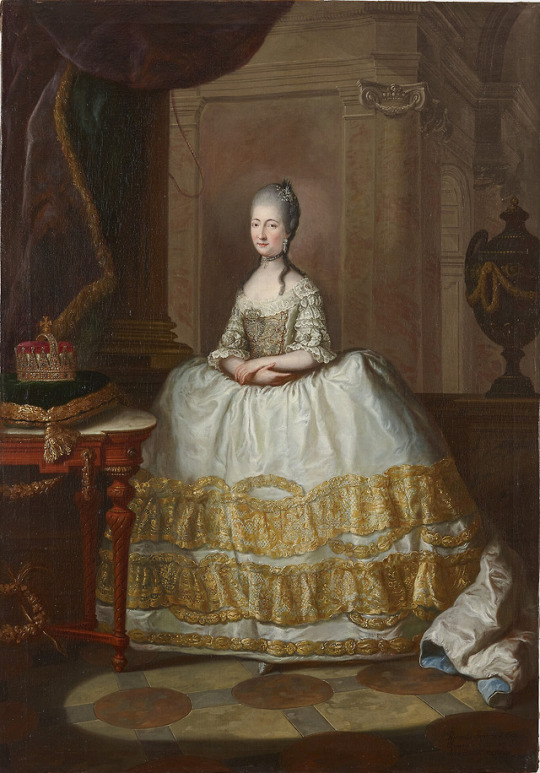
Maria Beatrice d’Este, Duchess of Massa (7 April 1750 - 14 November 1829)
#maria beatrice d'este#maria beatrice ricciarda#duchess of massa#daughter of ercole iii duke of modena#wife of ferdinand duke of breisgau#history#women in history#18th century#19th century#art
5 notes
·
View notes
Text
Le ingeniose sorti /
composte per Francesco Marcolini da Forli, intitulate Giardino di pensieri.
Description
Tools
Cite this
Export citation file
Main Author:
Marcolini, Francesco, approximately 1500-approximately 1559
Related Names:
Titian approximately 1488-1576
,
Salviati, Francesco 1510-1563
,
Porta, Giuseppe approximately 1520-approximately 1576
,
Dolce, Lodovico 1508-1568
Language(s): Italian Published: In Venetia : Per Fra[n]cesco Marcolino da Forli, ne glianni del Signore 1550 del mese di luglio.
Edition: Nouamente ristampate, e in nouo et bellissimo ordine riformate.
Subjects:
Tarot.
Fortune-telling by cards
Tarot
>
Tarot / Early works to 1800.
Fortune-telling by cards
>
Fortune-telling by cards / Early works to 1800.
Woodcuts (prints)
>
Woodcuts (prints) / Italy
>
Woodcuts (prints) / Italy / 16th century.
Early works.
Note: Includes verse text by Lodovico Dolce.
Paged according to text sections, with frequent repetitions; last page of text numbered 157.
Signatures: A-2C⁴.
Woodcut title page by Giuseppe Porta. It was designed by Porta's master Francesco Salviati. The design of Marcolini's port. on t.p. verso is attributed to Salviati or Titian. It differs from that in ed. of 1540; see Mortimer. Initial with putto, p. 4. Colophon with woodcut border includes Marcolini's device.
From initial questions (13 for men, 13 for women, 24 for either) the reader proceeds by drawing cards to 50 pages of virtues, vices, etc. (incorporating allegorical woodcuts), 50 pages of cards arranged in a "via croce," and ultimately to 50 pairs of pages of responses by various philosophers (incorporating woodcut ports.). Both of the pages pertaining to a philosopher bear the same page no., and 7 ports. that were repeated in the 1540 ed. have been replaced by new ones. The philosophers' three-line responses were versified by Lodovico Dolce. See Mortimer.
First edition by Marcolini appeared in October, 1540. Present ed. retains dedication to Ercole d'Este, duke of Ferrara.
Imprint from colophon; title page gives year only.
Physical Description: 157 [i.e. 207], [1] p. : ill. (woodcuts) ; 30 cm. (fol.)
2 notes
·
View notes
Photo

Ms. Codex 469 - Ethica secondo la dottrina d'Aristotile This manuscript features a work on ethics, divided into four books, that closely follows the work of Aristotle. It is dedicated to Ippolito d'Este, who was the cardinal of Ferrara, brother of Duke Ercole II, and patron of the arts. The author is Gabriel Cesano, Secretary to Ippolito de Medici, canon of the cathedral of Pisa, a protege of Catherine de Medici, and bishop of Saluzzo. It was possibly written there in Saluzzo around 1560 CE. Originally posted on Tumblr by Mario Sassi. #medieval #medievalmanuscript #manuscript #italy #pisa #aristotle #16thc https://instagr.am/p/CMUpc0ZA47K/
20 notes
·
View notes